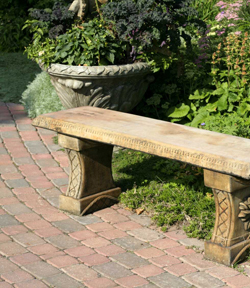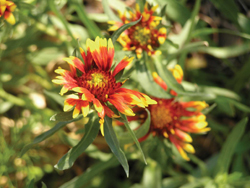YOUR HOME - EXTERIOR LOOKS
Wildfire Gardening
You can Help Keep your Home Safe
December, 2007 - Issue #38
 |
The best time to start preparing your garden and home for safety is before the danger becomes imminent, but any time is better than not doing it at all. So even if you feel you've safely passed through this most recent fire danger, there is no reason not to prepare now for the next. And, unless we are gifted with unexpected regular rains, the wildfire season is likely to be a long one due to the radical lack of rainfall this past year.
Fire-resistant can be Fabulous
First and foremost it is important to reiterate that a beautiful garden can, indeed, be a safe and wise garden. It is a common misconception that the only fire-wise and water-conscious garden is a dull cactus garden. There are, of course, ways to build cactus and succulent gardens so they are downright glamorous, and there are ways to design all other styles, be they English or Mediterranean, tropical or desert, contemporary or rustic or any other style to resist fire as well.
| "A beautiful garden
can indeed be a SAFE AND WISE garden." |
Here are just a few ideas. For a contemporary or artistic garden style, consider creating areas of ground-designed mosaics. With bender board you can outline areas to be filled with colored stone or tumbled glass and create wonderful designs to fill areas between gardens or along roads and walkways. For an Oriental or rustic look, check into the huge array of colored ornamental grasses that offer a low profile and little fuel for traveling fires. There are blue-colored grasses to be found with plants like the Blue Oat grass (Avena) or the low Fescue ovata glauca. Reds can be found in the red fountain grasses (Pennisetum a. rubrum) and the red, dwarf variety of New Zealand flax (Phormium "Tom Thumb"). Whites, yellows, oranges and many shades of green are available in ornamental grasses or grass-like plants. You can even find black with the black mondo grass (Ophiopogon "nigrescens").
 Gailardia |
Fire-resistant can also be Practical
You can design fire resistance into new or existing landscapes. Roads in larger properties or paths in smaller spaces afford firebreaks. And any size property can use areas of low-growing groundcovers. You can still grow trees and large shrubs, but if you group them together with non-flammable material - or at least low groundcover - between them, flames will not be so readily conducted through your property. Consider designing in gravel or stone gardens for low-maintenance, inflammable areas. These areas will save you on watering costs and provide practical sport, relaxation, pet and working areas. You can combine being artistic with being practical by designing in meandering pathways and open areas that are useful and offer no material for fires to burn. A pond or other water feature can create an exciting focal point while recycling the water for minimum usage - a wonderful, decorative and distinctly non-flammable use of garden space!
Plants and Flammability
Although pine trees wistfully bring to mind the cool shade of the forest, their appeal wanes a bit when you realize they are not only flammable, but they positively explode when ignited. If you want pines on your property, plant them at a good distance from your home. Eucalyptus trees in general are very flammable though certain varieties are more combustible than others. Usually the strong-scented, pungent foliage in plants means there is a concentration of essential oil in the cells and oils are readily ignited. More water is likely to be stored in large-leafed and lush foliage, so these plants will tend to resist fire a little more than the smaller leafed plants or, of course, those with a lot of oil.
Since many desert plants have adapted concentrated oils and smaller leaves for more efficient transpiration in hot, dry environments, many of the toughest plants are also more vulnerable to fires. Evolution encouraged many tropical plants to develop large flattened leaves to catch monsoonal rainfall. Unfortunately, that means most of the best-adapted plants for our chaparral environment are also the least ideal for fire resistance while the least adapted fare better in retarding fires.
However, I still opt for using the chaparral and desert plants over tropical imports and suggest using wise design to create fire resistance. Lack of water seems to be evolving into a crisis as dangerous as that of wildfires and the two are connected. Not only will the design of your landscape have a bigger impact on fire resistance than the plant choice, but drought-tolerant plants are still considerably lower in maintenance and higher in general survival rates.
| "Your chances of safely surviving a fire season by simply clearing brush and keeping to wise, fire-resistant planting can tip the odds HUGELY in your favor." |
Some Colorful Plant Solutions
Another way to choose plants is by their size and habit of growth. The issue of flammable plants can be a bit confusing as you will find strong oil-concentrated plants like rosemary on both the recommended and discouraged official lists for fire resistance.
Although these plants are flammable, they have a habit of growth that is both small and neat, presenting less incendiary-inviting profiles. There are a number of decorative plants that bloom colorfully, thrive in our challenging environment and have low growth habits that make them excellent for the fire-resistant garden. Try using the Salvia chamaedryoides for neat foot-high shrubs with grey foliage and brilliant sky-blue flowers. There are several germanders (teucreums) that are also well-mannered low growers with lots of flowers in pinks and purples. Two Salvias that have been bred from wild varieties to be low ground-covers are the Salvia "Bee's Bliss" and S. "Terra Secca." These stay nice and green all year round. All the above plants went through last winter's extreme cold snap without a trace of damage.
Double Duty Design
If you group thirsty plants closest to your home, you will save on water by concentrating it in small areas and keep these moisture-retentive, less-flammable growers close to where you most want to discourage fire. Albeit vegetables and showy garden flowers will be your major water-hogs, at least if you keep them close and grouped, you will get edibles and cut flowers as a bonus to being fire-wise. Since the area around the house is also where you should design the showiest flowers, you will, again, be getting the maximum effect for your expense as well as lowering flammability. To make the latter part work well, be sure to minimize taller plants and keep dry foliage and dead material cleaned. No matter what plants you use, if fire burns close enough, the heat will consume any plant as fuel no matter how moisture-retentive it may be.
Plan Ahead
If you are starting a new landscape, this is the ideal time to design in ways to keep any potential fire as far away from your home as possible. A combination of careful hardscape design (permanent features) and wise plant selection and positioning can make a remarkable difference. In a well-designed garden, these features can become assets, making your garden even more beautiful than it might have been otherwise. Swimming pools can be great
fire protectors, offering a buffer zone and a source for water to fight potential fires. If your neighbors also have pools, you might want to work with authorities to organize a plan for future emergency preparedness. And if you have your landscape done already, you might want to take a little time to think about features you could add to make your garden more effective in times of fire.
That said, here are a few reminders about what you can do now. Trees constantly drop leaves, seeds, branches and pine-needles that are swept up by winds to lodge in gutters and rooftop areas.
Keeping these dry kindling materials cleared from your residence is a simple but important job. Autumn and winter are the best times to prune trees, yet anytime is a good time to remove dead branches or branches that reach within 10 feet of your home. Better yet, don't plant trees too close to the house in the first place. And remember to keep the more flammable pines and eucalyptus away from structures.
Planning artistically and practically can give you a lovely, functional and fire-resistant landscape. Keeping that landscape neat and clean will remove the fast-burning fodder fires thrive on. Fires are a fact of life in the chaparral, but with a little effort, we can incorporate this challenge into a landscaping lifestyle that should reduce fire-season stress, harmonize with the environment and offer a beautiful, comfortable garden to enjoy!
|
||||||||||||||||||||||||||||





